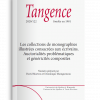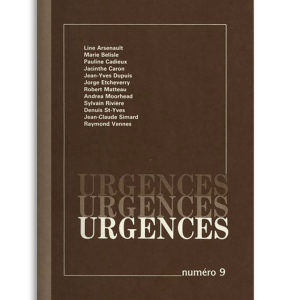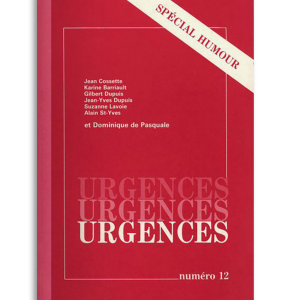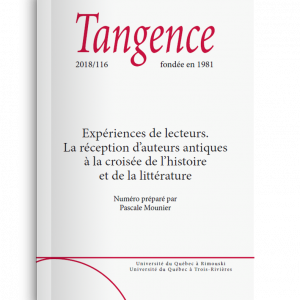Literary portraits and genericity
Dominique Maingueneau
This article examines commercial collections, notably Écrivains de toujours and Poètes d’aujourd’hui, with regard to genericity. Using a typology of genres of discourse, it proposes to show why texts published in these collections are necessarily highly diverse ; their one constraint is to respect the boundaries separating them from school books on one hand and literature on the other. At the same time, their authors are not, generally speaking, major writers and must present themselves as “connaisseurs”, rather than teachers, of literature. The comparison with the genre of “literary memories”, now dying out, is enlightening in this regard. This dual instability of genre and authors’ status is observed throughout the writing of these books, which demonstrate a “cultured” ethos. This is shown by the study of a passage from Pascal (“Écrivains de toujours”) by Albert Béguin, an author who well represents the spirit of the collection concerned.
Author’s image between uniqueness and seriality : the collection “Écrivains de toujours” in the 1950s
Ruth Amossy
This article analyzes the “author’s image” from a generic and serial perspective as constructed in the collection “Écrivains de toujours” during the first decade of its publication (the 1950s). It highlights the general author profile for the books “X by him or herself” by showing how the latter form the basis of the collection. Thus, the issue is both to explore the regulation of a genre of discourse and contribute to the study of the author’s image in its relationship to the discursive ethos.
The literarity of an icono-biographical collection. The “Albums de la Pléiade” (Gallimard)
Marcela Scibiorska
The collection “Albums de la Pléiade”, intended to promote Gallimard’s renowned “Bibliothèque de la Pléiade”, includes a series of volumes dedicated to the life of writers formerly published by the Pléiade, who are supported by a rich iconography accompanied by a biographical text. However, the authors of many introductory texts in the “Albums” defy reader’s expectations and explicitly refuse to classify their works as biographical. This article examines the reasons for this rejection of biography in the collection. At the same time, it discusses biography’s position as a largely marginalized genre within a literary field and its relationship to iconography, claimed to be the core element of the generic composition of the “Albums de la Pléiade.”
“Poètes d’aujourd’hui” (1944-2007) : collection of anthologies, anthology collection
Mathilde Labbé
Each volume of the collection “Poètes d’aujourd’hui”, created in 1944 by Pierre Seghers, systematically includes a critical and biographical essay ; a choice of texts or an anthology ; a biography or chronology ; a bibliography of the author’s works together with studies of them ; and, finally, a set of illustrations. Among the critical genres mentioned, the anthology (or choice of texts) appears to be an element all the harder to understand insofar as it places the functioning of the collection of monographs within the collection of which it is part. To examine the nature and functions of this critical genre in the éditions Seghers collection “Poètes d’aujourd’hui” is to inquire about the objectives of the collection itself. However, although the biographical genre is regularly examined and rejected in the critical essay, the anthological genre is very rarely discussed by the authors of the volumes. Why the silence ? What role is explicitly accorded to anthology ? What implicit role does it play ? If anthology is obviously the core of the collection’s editorial project, the a-critical position of the publisher and the authors in this section of the works is surprising ; its functioning can only be understood by examining the anthological dimension of the collection itself.
Face to face : (self) portraits of the writer II. The interview in the collections “Qui êtes-vous ?” (La Manufacture) and “Les contemporains” (Le Seuil)
David Martens
Collections of illustrated monographs underwent a significant change during the 1980s in France, a change reflected by the creation of two new series characterized by a stronger focus on contemporary writers : “Qui êtes-vous ? ” (La Manufacture, 1985) and “Les contemporains” (Le Seuil, 1988). From a generic viewpoint, a key feature of both series is the integration of interviews with the writer presented. Continuing a previous study on these two collections, the present article examines the functions assigned to interviews in the discursive economy of these works and how the use of said interviews tends to harmonize them with the discursive space of the work represented by the writer.
Portraits of writers in series. The composite genericity of illustrated pocket monographs
David Martens
The works published in collections of illustrated monographs reprise and adapt the formula initiated by “Poètes d’aujourd’hui” and quickly reprised by “Écrivains de toujours”, which consists of presenting a critical essay, a choice of texts and a few pictures. Based on archival documents testifying to a form of uncertainty regarding the supposed genre of these works, this article focuses on the particular genericity of these arrangements of texts and pictures from distinct genres. If they differ, at a formal level and as regards the ways of shaping the image of the author they represent, the texts shown are part of a behind-the-scenes portrait enterprise that governs both the volumes of these collections and their overall constitution.






